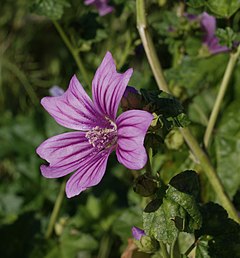Malva
| Malva subsp. var. | ||||||||||||||||||||||||||||||||||||||||||||||||||||||||
|---|---|---|---|---|---|---|---|---|---|---|---|---|---|---|---|---|---|---|---|---|---|---|---|---|---|---|---|---|---|---|---|---|---|---|---|---|---|---|---|---|---|---|---|---|---|---|---|---|---|---|---|---|---|---|---|---|

|
|
| ||||||||||||||||||||||||||||||||||||||||||||||||||||||
| ||||||||||||||||||||||||||||||||||||||||||||||||||||||||
Malva is a genus of about 25–30 species of herbaceous annual, biennial, and perennial plants in the family Malvaceae (of which it is the type genus), one of several closely related genera in the family to bear the common English name mallow. The genus is widespread throughout the temperate, subtropical and tropical regions of Africa, Asia and Europe.[1]
The leaves are alternate, palmately lobed. The flowers are from 0.5–5 cm diameter, with five pink or white petals.
The colour mauve was in 1859 named after the French name for this plant. Several species are widely grown as garden flowers, while some are invasive weeds, particularly in the Americas where they are not native.
Many species are edible as leaf vegetables.
| Standard Cyclopedia of Horticulture |
|---|
|
Malva (old Latin name from Greek, referring to the emollient lvs.). Malvaceae. Various annual, biennial and perennial herbs, of considerable use in ornamental plantings. From numerous allied genera, Malva is distinguished by the carpels in a single whorl: ovules solitary, ascending: bractlets 3, distinct: carpels not beaked or appendagcd within. They are hirsute or nearly glabrous plants: lvs. angled, lobed or dissected: fls. solitary in the axils, or clustered, sessile or peduncled; petals 5, notched at the apex.— Species in the neighborhood of 30, in Eu., N. Afr., Asia; several are naturalized in N. Amer.—Few of the mallows are generally in the trade. The most common one is M. moschata, although M. crispa is frequently seen in gardens for its tall striking growth. They require no special cultural treatment. The genus has been more closely defined in recent time, and some of the plants that belong in Callirhoe, Malvastrum,and Sphaeralcea are still likely to be listed under Malva. M campanulata, Paxt.-Malvastrum.—M. capensis. Linn.- Mulvastrum.—M. coccinea, Nutt.-Malvastrum.—M. insolucrata, Torr. & Gray-Callirhoe.—M. laterilio. Hook—Malvastrum.—M. miniata Cav -Sphaeralcea M. papaver Cav - Callirhoe M pedata Torr & Gray - Callirhoe M pedata Torr & Gray Callirhoe M umbellata Cav - Sphaeralcea.
|
Cultivation
Very easily grown, short-lived perennials often grown as ornamental plants. Mild tasting young mallow leaves can be a substitute for lettuce, whereas older leaves are better cooked as a leafy green vegetable. The buds and flowers can be used in salads.
Propagation
Cultivation is by sowing the seeds directly outdoors in early spring. The seed is easy to collect, and they will often spread themselves by seed.
Pests and diseases
Species
- Malva aegyptia
- Malva alcea L.-- Greater Musk-mallow, vervain mallow
- Malva assurgentiflora
- Malva brasiliensis Desr. -- Brazilian mallow
- Malva canariensis
- Malva cretica
- Malva dendromorpha -- Tree Mallow
- Malva hispanica
- Malva microcarpa
- Malva microphylla
- Malva mohileviensis
- Malva moschata L. -- Musk-mallow
- Malva neglecta - Dwarf Mallow. buttonweed, cheeseplant, cheeseweed, common mallow, roundleaf mallow
- Malva nicaeensis All. - French Mallow, bull mallow
- Malva oxyloba
- Malva pacifica
- Malva parviflora L. -- Least Mallow, cheeseweed, cheeseweed mallow, small-whorl mallow
- Malva preissiana - Australian Hollyhock
- Malva pseudolavatera
- Malva pusilla - Small Mallow
- Malva qaiseri
- Malva rotundifolia L. -- low mallow, Malva rotundifolia
- Malva sinensis
- Malva stipulacea
- Malva sylvestris L. -- Common Mallow, high mallow
- Malva tournefortiana
- Malva trifida
- Malva verticillata L. -- Chinese Mallow, cluster mallow
- Malva wigandii
Gallery
References
- ↑ Cite error: Invalid
<ref>tag; no text was provided for refs namedmi
- Standard Cyclopedia of Horticulture, by L. H. Bailey, MacMillan Co., 1963
